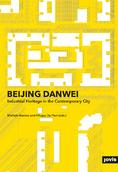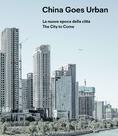premio letteratura urbanistica central places smart city safety & security creativity heritage local development globalization ifau2018 open position premio gubbio 2018 inclusive processes special news city climate change energy collaborative urban design participation Community renaissance welfare populations information technology periodic news outskirts & suburbs
BEIJING DANWEI
Industrial Heritage
in the Contemporary City
Michele Bonino | Filippo De Pieri
Danwei these were urban sectors in China that were characterized by close links between work, residence, and social facilities. They are the material product of socialist city planning and therefore provide an urban experience that forms a stepping stone between the Hutongs of the imperial capital and the superblocks of the present-day metropolis. Contrary to the disused industrial sites in western cities that often disrupt the continuity and scale of the urban fabric, the danwei have a much closer relationship to the historical, as well as the contemporary city. In modern-day Beijing, the danwei represent a unique experimental field of urban design. Beijing Danwei looks at the history and future of former danwei and presents exemplary strategies for dealing with industrial heritage. Case studies show the problems that go hand in hand with transformation and present perspectives and potential with regard to usage and the urban regeneration of Beijing. The book includes essays by the editors, as well as by Pierre-alain Croset, Gary Hack, Thomas Herzog, Liu Boying, Liu Jian, Lu Duanfang, Shen Yuan, and Zhu Wenyi. With a visual essay by Jia Yue and Maria Paola Repellino.
The book is composed of three parts. A series of essays written by leading members of the research group and invited experts opens the publication. They outline the role played by danwei areas in the history of modern Beijing, and discuss the challenges that the physical and cultural heritage of the collectivist era poses to present-day urban transformations. A detailed analysis of four case studies of former industrial danweis forms the core of the second part. The book is closed by two epilogues, which put the previously collected materials in a wider perspective and elaborate on potential future scenarios.
CONTENTS
Preface | 5
Michele Bonino, Filippo De Pieri, Zhang Li
1. ESSAYS
Beijing, City of Danweis | 10
Michele Bonino, Filippo De Pieri
The Danwei-based Communities of Beijing | 25
Li Weidong
The Work Unit and the Foxconn Factory: A Comparative Perspective | 36
Lu Duanfang
Transformation of Industrial Layout in the Spatial Planning of Beijing | 56
Liu Jian
The Danwei and the City | 74
Gary Hack
2. CASE STUDIES
Visual essay | 86
photos by Jia Yue; drawings by Maria Paola Repellino
BEIJING NO.2 TEXTILE FACTORY | 112
Different Urban Renewal Solutions |113
Maria Paola Repellino
The Construction History of Beijing no. 2 Textile Factory | 116
Sun Haode
Family Danwei | 122
Maria Paola Repellino
Factory and Home: A Portrait of Family Life | 130
Maria Paola Repellino
Interview with Cheng Yu | 131
Gu Feng
Interview with Lai Guowei and Xia Tian | 132
Lu Quanqing
XINHUA 1949 | 134
A Flagship Cultural Showcase | 135
Maria Paola Repellino
A Critical Construction History | 138
Daniela Hidalgo Molina
Memory and Postindustrial Identity | 140
Maria Paola Repellino
Three Changes of xinhua 1949 Cultural Creative Park | 146
Liu Boying
Interview with Architect Luo Jin | 149
Lu Quanqing
BEIJING NO.2 THERMAL POWER PLANT | 150
The Chimney and the Temple | 151
Arturo Pavani
History of the Thermal Power Plant | 157
Daniela Hidalgo Molina
SHOUGANG ERTONG GENERAL MACHINERY PLANT | 158
The Industrial Shell | 159
Arturo Pavani
Living in Ertong: Voices from the Residents | 169
Sun Haode, with contributions by Gu Feng
A Design Experience in Ertong | 172
Thomas Herzog
3. CONCLUSIONS
The Palimpsest and the Archipelago: The Danwei as a new Urban Project | 178
Pierre-Alain Croset
The Danwei as a Prototype of Beijing Urban Space | 182
Zhu Wenyi
Image Credits | 187
The Authors | 189
ABOUT THE RESEARCH:
This book is the result of a partnership between Politecnico di Torino, Italy, and Tsinghua University in Beijing. The research on the former industrial danwei areas of Beijing was primarily carried out in 2014 under the general coordination of Michele Bonino and Filippo De Pieri. Four scholars from Torino—the two editors, Arturo Pavani and Maria Paola Repellino—spent extended research time in Beijing for a review of the literature, meetings and seminars, interviews with stakeholders and inhabitants, archival research, and fieldwork. Four scholars from Tsinghua—Zhang Li, Martijn de Geus, Daniela Hidalgo, and Sun Haode—also spent extended periods of time in Italy.
ABOUT THE AUTHORS:
Michele Bonino Associate Professor, Politecnico di Torino, Italy. Partner at MARC | Filippo De Pieri Assistant Professor, Politecnico di Torino, Italy.




Planum
The Journal of Urbanism
ISSN 1723-0993
owned by
Istituto Nazionale di Urbanistica
published by
Planum Association
ISSN 1723-0993 | Registered at Court of Rome 4/12/2001, num. 514/2001
Web site realized by ChannelWeb & Planum Association | Powered by BEdita 3










